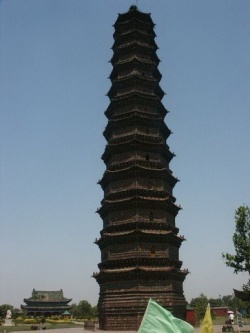Difference between revisions of "Iron Pagoda"
m (1 revision: link) |
m (Text replace - "Right" to "Right") |
||
| Line 8: | Line 8: | ||
Historical records show that the [[Pagoda]] experienced 38 earthquakes, 10 hailstones, 19 disasters caused by windstorms and 6 floods. Especially, it suffered bombings by Japanese planes and cannons in 1938. However, it has stood for over 900 years and remains intact. | Historical records show that the [[Pagoda]] experienced 38 earthquakes, 10 hailstones, 19 disasters caused by windstorms and 6 floods. Especially, it suffered bombings by Japanese planes and cannons in 1938. However, it has stood for over 900 years and remains intact. | ||
| − | About one hundred meters west of the Iron [[Pagoda]] is a grand hall with lacquered ridgepoles and painted girders. The hall, with 24 big poles supporting it, is the largest hall in the Iron [[Pagoda]] Park, also called the Welcoming [[Buddha]] Hall. The figure of [[Buddha]] in the hall is 5.14 meters high and weighs 12 tons. The [[Buddhist]] figure made of copper, has eleemosynary appearance and heavenly manner with its left hand on the [[Heart]] and | + | About one hundred meters west of the Iron [[Pagoda]] is a grand hall with lacquered ridgepoles and painted girders. The hall, with 24 big poles supporting it, is the largest hall in the Iron [[Pagoda]] Park, also called the Welcoming [[Buddha]] Hall. The figure of [[Buddha]] in the hall is 5.14 meters high and weighs 12 tons. The [[Buddhist]] figure made of copper, has eleemosynary appearance and heavenly manner with its left hand on the [[Heart]] and Right hand drooping. It stands barefoot on a [[Lotus]] flower platform and seems ready to guide Buddhists, who have cultivated themselves according to religious doctrines, to the western Elysium. The walls around the [[Buddhist]] figure are painted with a large-scale mural The Western Elysium, on which there are 70 josses including [[Bodhisattva]], fairies, Flying Apsaras, and so on. |
On the east of the Iron [[Pagoda]] is the site of a [[Buddhism]] Institute established in the 1930s, which consists of a display room for cultural [[Relics]] of the Iron [[Pagoda]] and a pavilion to commemorate Yu Hao. | On the east of the Iron [[Pagoda]] is the site of a [[Buddhism]] Institute established in the 1930s, which consists of a display room for cultural [[Relics]] of the Iron [[Pagoda]] and a pavilion to commemorate Yu Hao. | ||
Revision as of 17:04, 8 September 2013
Located in the Iron Pagoda Park in the northeast part of the Kaifeng City, the Iron Pagoda is called as the First Pagoda under Heaven by people for its exquisite architectural design and magnificent structure.
The Pagoda was built in 1049 during the Northern Song Dynasty (960-1127). With a history of more than nine hundred years, it is one of the earliest constructions made of glazed bricks and tiles in China. It got its Name from the iron-gray color of its glazed bricks. Its predecessor was a wood Pagoda built by Yu Hao, a noted architect in the Northern Song Dynasty, to worship Buddhist Relics of Sakyamuni. The wood Pagoda was burnt down in a Fire caused by lightning in 1044. Song Emperor Renzong ordered to build an iron Pagoda in Yishan Mountain, close to the wood Pagoda according to its style. This is the iron-gray Pagoda we see today.
The octagonal Pagoda is 56.88 meters high and has thirteen levels, with its base buried in silt from the Yellow River. Although it was constructed of glazed bricks of different shapes and sizes, it looks very much like a huge wooden pillar, with carved patterns of Buddhas, Flowers, human figures and legendary Animals, all representing the highly developed workmanship of the Song Dynasty. The top of the Pagoda affords a good view of the whole city of Kaifeng. Hanging under the eaves are 104 bells, giving wonderful tinkles in the breezes. There are 168 steps, winding upwards along the central pillar, by which the visitors can reach the summit of the Pagoda.
Historical records show that the Pagoda experienced 38 earthquakes, 10 hailstones, 19 disasters caused by windstorms and 6 floods. Especially, it suffered bombings by Japanese planes and cannons in 1938. However, it has stood for over 900 years and remains intact.
About one hundred meters west of the Iron Pagoda is a grand hall with lacquered ridgepoles and painted girders. The hall, with 24 big poles supporting it, is the largest hall in the Iron Pagoda Park, also called the Welcoming Buddha Hall. The figure of Buddha in the hall is 5.14 meters high and weighs 12 tons. The Buddhist figure made of copper, has eleemosynary appearance and heavenly manner with its left hand on the Heart and Right hand drooping. It stands barefoot on a Lotus flower platform and seems ready to guide Buddhists, who have cultivated themselves according to religious doctrines, to the western Elysium. The walls around the Buddhist figure are painted with a large-scale mural The Western Elysium, on which there are 70 josses including Bodhisattva, fairies, Flying Apsaras, and so on.
On the east of the Iron Pagoda is the site of a Buddhism Institute established in the 1930s, which consists of a display room for cultural Relics of the Iron Pagoda and a pavilion to commemorate Yu Hao.
In the Iron Pagoda Park, a lake, a corridor over the water, waterside pavilions, man-made rockeries and springs were constructed in recent years, to entertain the tourists.
